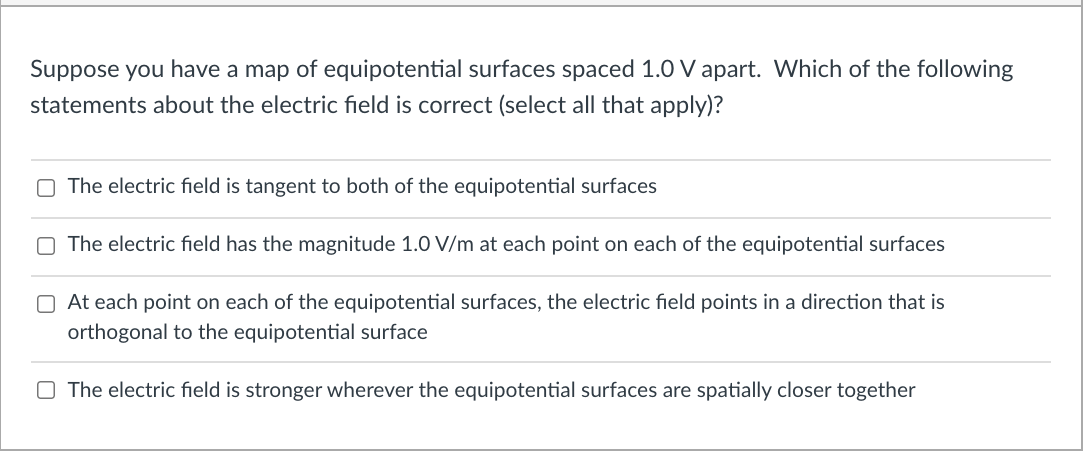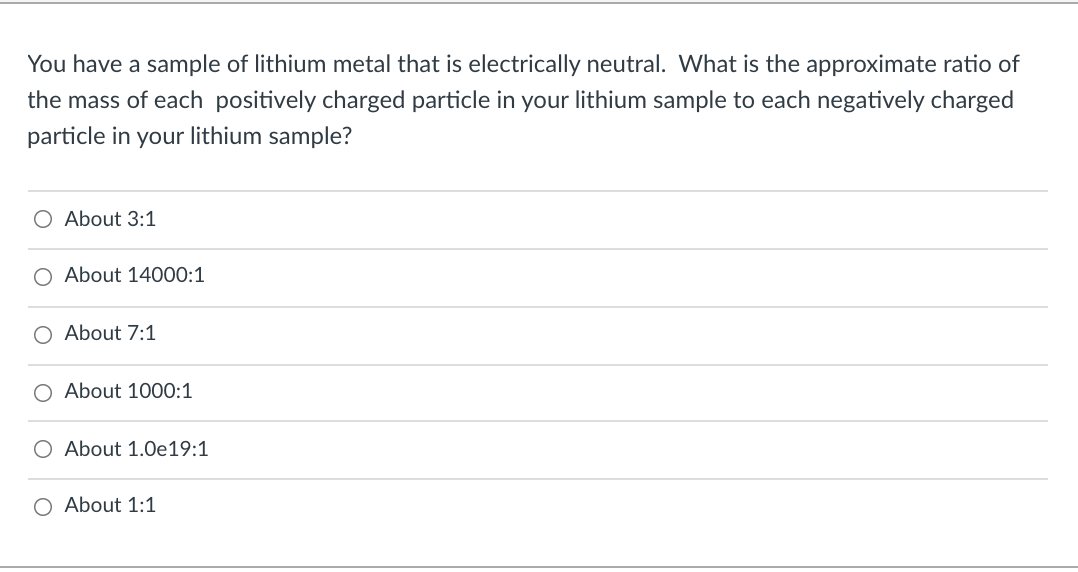Suppose you have a map of equipotential surfaces spaced 1.0 V apart. Which of the following statements about the electric field is correct (select all that apply)? O The electric field is tangent to both of the equipotential surfaces O The electric field has the magnitude 1.0 V/m at each point on each of the equipotential surfaces O At each point on each of the equipotential surfaces, the electric field points in a direction that is orthogonal to the equipotential surface O The electric field is stronger wherever the equipotential surfaces are spatially closer together
Suppose you have a map of equipotential surfaces spaced 1.0 V apart. Which of the following statements about the electric field is correct (select all that apply)? O The electric field is tangent to both of the equipotential surfaces O The electric field has the magnitude 1.0 V/m at each point on each of the equipotential surfaces O At each point on each of the equipotential surfaces, the electric field points in a direction that is orthogonal to the equipotential surface O The electric field is stronger wherever the equipotential surfaces are spatially closer together
Classical Dynamics of Particles and Systems
5th Edition
ISBN:9780534408961
Author:Stephen T. Thornton, Jerry B. Marion
Publisher:Stephen T. Thornton, Jerry B. Marion
Chapter5: Gravitation
Section: Chapter Questions
Problem 5.1P
Related questions
Question

Transcribed Image Text:Suppose you have a map of equipotential surfaces spaced 1.0 V apart. Which of the following
statements about the electric field is correct (select all that apply)?
O The electric field is tangent to both of the equipotential surfaces
O The electric field has the magnitude 1.0 V/m at each point on each of the equipotential surfaces
O At each point on each of the equipotential surfaces, the electric field points in a direction that is
orthogonal to the equipotential surface
O The electric field is stronger wherever the equipotential surfaces are spatially closer together

Transcribed Image Text:You have a sample of lithium metal that is electrically neutral. What is the approximate ratio of
the mass of each positively charged particle in your lithium sample to each negatively charged
particle in your lithium sample?
O About 3:1
O About 14000:1
O About 7:1
O About 1000:1
O About 1.0e19:1
O About 1:1
Expert Solution
This question has been solved!
Explore an expertly crafted, step-by-step solution for a thorough understanding of key concepts.
This is a popular solution!
Trending now
This is a popular solution!
Step by step
Solved in 2 steps

Recommended textbooks for you

Classical Dynamics of Particles and Systems
Physics
ISBN:
9780534408961
Author:
Stephen T. Thornton, Jerry B. Marion
Publisher:
Cengage Learning


Physics for Scientists and Engineers: Foundations…
Physics
ISBN:
9781133939146
Author:
Katz, Debora M.
Publisher:
Cengage Learning

Classical Dynamics of Particles and Systems
Physics
ISBN:
9780534408961
Author:
Stephen T. Thornton, Jerry B. Marion
Publisher:
Cengage Learning


Physics for Scientists and Engineers: Foundations…
Physics
ISBN:
9781133939146
Author:
Katz, Debora M.
Publisher:
Cengage Learning

Principles of Physics: A Calculus-Based Text
Physics
ISBN:
9781133104261
Author:
Raymond A. Serway, John W. Jewett
Publisher:
Cengage Learning

College Physics
Physics
ISBN:
9781305952300
Author:
Raymond A. Serway, Chris Vuille
Publisher:
Cengage Learning

College Physics
Physics
ISBN:
9781285737027
Author:
Raymond A. Serway, Chris Vuille
Publisher:
Cengage Learning